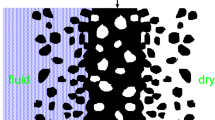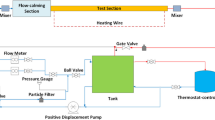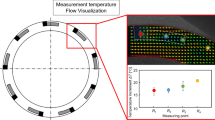Abstract
For examining friction-factor characteristics of round-hole pattern surfaces which are usually applied on damper seals, flat plate test apparatus is designed and fabricated. The measurement method of leakage and pressure distribution along round-hole pattern specimen with different hole area is described and a method for determining the Fanning friction factor is discussed. Results show that the round-hole pattern surfaces provide a much larger friction factor than smooth surface, and the friction factor vs. clearance behavior yields that the friction factor generally decreases as the clearance increases unlike the results of Nava’s flat plate test. As the hole depth is decreased, the friction factor is increased, and maximum friction factor is obtained for 50% of hole area. Since the present experimental friction factor results show coincident characteristics with Moody’s friction factor model, empirical friction factors for round-hole pattern surfaces are obtained by using the Moody’s formula based on curve-fit of the experimental data. Results of Villasmil’s 2D CFD simulation support the present experimental test result.
Similar content being viewed by others
Abbreviations
- A:
-
Cross-sectional area (m2)
- a, b, c:
-
Coefficients of Moody’ friction factor model in Eq. (2)
- c1 :
-
Clearance of test section (m)
- d:
-
Hole depth (m)
- D:
-
Pipe diameter (m)
- Dh :
-
Hydraulic diameter in Eq. (4) (m)
- e:
-
Absolute roughness (m)
- f:
-
Fanning friction factor in Eq. (7)
- fB :
-
Blasius model of friction factor in Eq. (1)
- fM :
-
Moody model of friction factor in Eq. (2)
- hf :
-
Pressure loss due to friction effect in Eq. (3) (Pa)
- 1:
-
Total distance of ΔP (m)
- ΔP:
-
Pressure drop (Pa)
- Q:
-
Flow rate (m3/s)
- Re:
-
Reynolds number in Eq. (6)
- v:
-
Flow velocity in Eq. (5) (m/s)
- w:
-
Width of test section (m)
-
 :
: -
(hole area/total area) x 100(%)
- γ :
-
Fluid viscosity (N-s/m2)
- ρ :
-
Fluid density (kg/m3)
- φ :
-
Hole diameter (m)
References
Childs, D.W., and Kim, C.-H., 1985, “Analysis and Testing for Rotordynamic Coefficients of Turbulent Annular Seals with Different, Directionally-Homogeneous Surface-Roughness Treatment for Rotor and Stator Elements,”ASME Journal of Tribology, Vol. 107, No. 3, pp. 296–306.
Childs, D.W., and Kim, C.-H., 1986, “Test Results for Round-Hole-Pattern Damper Seals: Optimum Configurations and Dimensions for Maximum Net Damping,”ASME Journal of Tribology, Vol. 108, pp. 605–611.
Childs, D. W., Nolan, S. A., and Kilgore, J. J., 1990, “Additional Test Results for Round-Hole-Pattern Damper seals: Leakage, Friction Factors, and Rotordynamic Force Coefficients,”ASME Journal of Tribology, Vol. 112, pp. 365–371.
Childs, D.W., and Fayolle, P., 1999, “Test Results for Liquid “Damper” Seals using a Round Hole Roughness Pattern for the Stators,”ASME Journal of Tribology, Vol. 121, pp. 42- 49.
Ha, T. W., and Childs, D. W., 1992, “Friction-Factor Data for Flat Plate Tests of Smooth and Honeycomb Surfaces,”ASME Journal of Tribology, Vol 114, pp. 722–730.
Ha, T. W., and Lee A. S., 1998, “A Modeling of Pump Impeller Shroud and Wear-Ring Seal as a Whole, and Its Application to the Pump Rotor- dynamics,”KSME International Journal, Vol. 12, No. 3, pp. 441–450.
Ha, T. W., Lee, Y. B., and Kim, C. H., 2002, “Leakage and Rotordynamic Analysis of a High Pressure Floating Ring Seal in The Turbo Pump Unit of a Liquid Rocket Engine,”Tribology International, Vol. 35, pp. 153–161.
Ha, T. W., Ju, Y. C., Lee, Y. B., and Kim, C. H., 2003, “Characteristics of Friction Factor for Artificially Roughened Surfaces,”Journal of Fluid Machinery, Vol. 6, No. 3, pp. 15–20.
Hirs, G., 1973, “A Bulk-Flow Theory for Turbulence in Lubricant Films,”ASME Journal of Lubrication Technology, pp. 137–146.
Holman, J. P., 1978,Experimental Methods for Engineers, McGraw-Hill, pp. 45.
Iwatsubo, T., and Sheng, B., 1990, “An Experimental Study on the Static and Dynamic Characteristics of Damp Seals,”in Proceedings of the Third IFToMM International Conference on Rotordynamics, Lyon, france, pp. 307–312.
Nava, D. L., 1993, “Observation of Friction Factors for Various Roughness Patterns in Channel Flow,” M.S. Thesis, Texas A&M University and Turbomachinery Laboratory Report No. TL-Seal-13-95.
Nelson, C., and Nguyen, D., 1987, “Comparison of Hirs’ Equation with Moody’s Equation for Determining Rotordynamic Coefficients of Annular Pressure Seals,”Journal of Tribology, Vol 109, pp. 144–148.
Potter, M. C., and Foss, J. F., 1975,Fluid Mechanics, Okemos, MI, Great Lakes Press, pp. 282–284.
Villasmill, L. A., 2002, “Understanding The Friction Factor Behavior in Liquid Annular Seals with Deliberately Roughened Surfaces, A CFD Approach,” M.S. Thesis, Texas A&M University.
Von Pragenau, G., 1982, “Damping Seals for Turbomachinery,” NASA Technical Paper No. 1987.
Author information
Authors and Affiliations
Corresponding author
Rights and permissions
About this article
Cite this article
Ha, T.W. Test results of friction factor for round-hole roughness surfaces in closely spaced channel flow of water. KSME International Journal 18, 1849–1858 (2004). https://doi.org/10.1007/BF02984333
Received:
Revised:
Issue Date:
DOI: https://doi.org/10.1007/BF02984333





 :
: